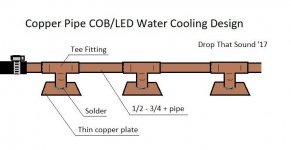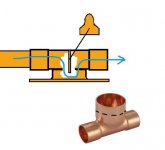Drop That Sound
Well-known member
f-e I like the way you think. I though about flattening (flat-earthening?) some copper pipe too, but then I thought a little harder and came up with this design below. I have all the parts to make it just never tried yet. Even have the copper sheeting, which I would hope simply soldering to a tee fitting would hold up.
Copper always seems to kink and develop cracks, I wouldn't hammer on it, but could still be done if done right. Maybe you could stick a small square block (like a 2"L x 3/4" x 3/4 into the center of a short length of say 1" diameter pipe, you could squeeze it with a vice. Or flatten one side of a rod that fits. Then pop it out, and put that flattened piece in between 2 reducing couplers.
Your other designs look like they would work well. Wish copper stuff wasn't so spendy! I got lots of pipe/fittings/scraps to play with and test on, if I ever had the time.
Good idea about using just a corrosion inhibitor instead of coolant. At least i think so, hopefully it would mix into the water and still do its job.
Oil might work, as in mineral oil, etc. If you did spring a leak it wouldn't mess with the electronics, but would be a pain to clean up. I've seen vids where guys submerge COB's directly into the oil (usually PCs), even in jars so the light shines out the bottom. Not exactly something I would want in my rooms but "cool" none the less.
Copper always seems to kink and develop cracks, I wouldn't hammer on it, but could still be done if done right. Maybe you could stick a small square block (like a 2"L x 3/4" x 3/4 into the center of a short length of say 1" diameter pipe, you could squeeze it with a vice. Or flatten one side of a rod that fits. Then pop it out, and put that flattened piece in between 2 reducing couplers.
Your other designs look like they would work well. Wish copper stuff wasn't so spendy! I got lots of pipe/fittings/scraps to play with and test on, if I ever had the time.
Good idea about using just a corrosion inhibitor instead of coolant. At least i think so, hopefully it would mix into the water and still do its job.
Oil might work, as in mineral oil, etc. If you did spring a leak it wouldn't mess with the electronics, but would be a pain to clean up. I've seen vids where guys submerge COB's directly into the oil (usually PCs), even in jars so the light shines out the bottom. Not exactly something I would want in my rooms but "cool" none the less.
Attachments
Last edited:






